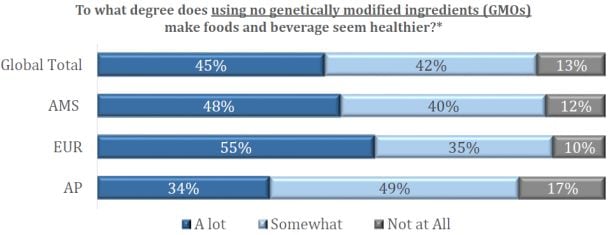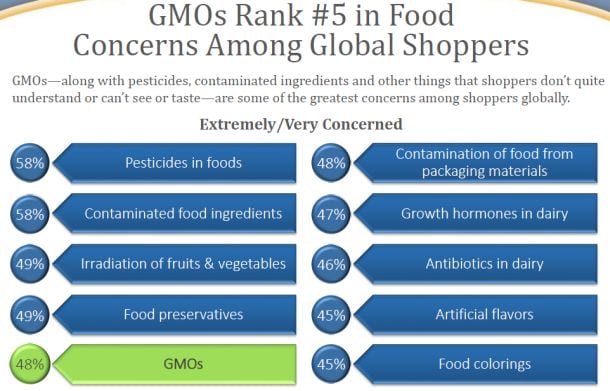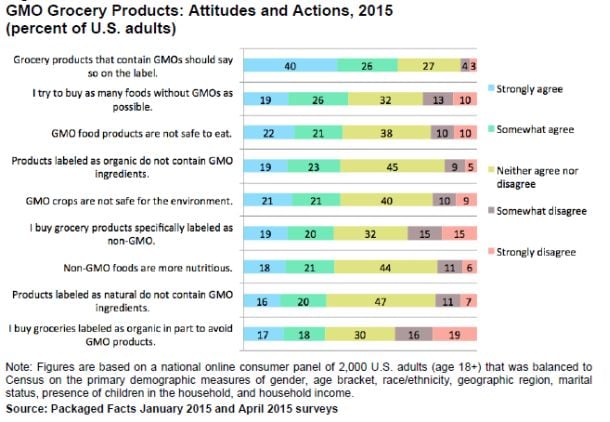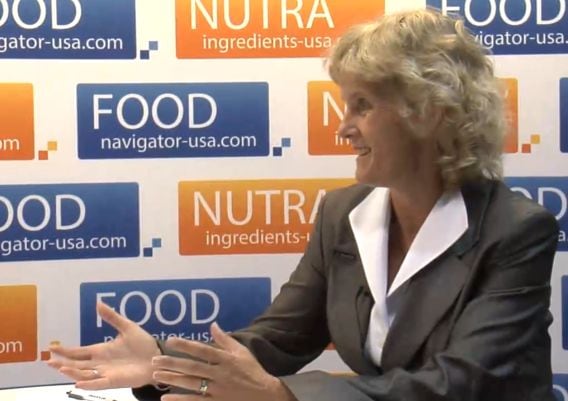And while products such as caramel color, starch, or oils and sweeteners from genetically engineered corn may be nutritionally and chemically indistinguishable from their non-GMO counterparts, 63% of consumers think they are “less safe to eat”.
Meanwhile, more than half of consumers surveyed (55%) also believe GM crops are “worse for the environment”, adds Health Focus International, which surveyed 2,300 US primary grocery shoppers, and 500-1,000 shoppers per country in Canada, Brazil, Mexico, the UK, France, Germany, Italy, Russia, Spain, Japan, China, Australia, India, Indonesia and the Philippines in 2014.
“GMOs rank within the top five food concerns globally. GMO concern is even surpassing ingredient concerns such as sugar, sodium, hydrogenated oils and artificial ingredients.”
The findings are echoed in a separate survey of 2,000 US consumers conducted by Packaged Facts earlier this year, which found that 43% of Americans agree with the statement ‘GMO food products are not safe to eat’, while 42% believe that ‘GMO crops are not safe for the environment’ and 39% believe non-GMO foods are ‘more nutritious’.
Levels of concern about GMOs vary between countries, with 22% of Indian consumers and 28% of UK consumers saying they are concerned about GMOs compared with 71% of Chinese consumers, 61% of Italians, 61% of Russians, 56% of Mexicans, 55% of Brazilians and 49% of Americans surveyed by Health Focus International.
The food industry shot itself in the foot by opposing the labeling initiatives
So what should we make of these findings, and is there any evidence than GM foods are “less safe to eat”?

Not according to the European Commission, the National Academy of Sciences, the American Medical Association, the World Health Organization, the Royal Society, the FDA, and the American Association for the Advancement of Science.
However, the consumer survey data is not wholly surprising “given the avalanche of information coming out on GMOs has been so one-sided, coming primarily from groups trying to protect their market share from a newer, better technology”, Dr Wayne Parrott, professor of crop science at the University of Georgia, told FoodNavigator-USA.
“The food industry shot itself in the foot by opposing the labeling initiatives… but without explaining what the technology is all about, even though they have a great product to talk about.”
The food industry urgently needs to regain the initiative, he said: “They started one [an education campaign] in 2004, but quickly dropped it, not realizing that nature abhors a vacuum. If the food industry does not deliver the message, someone will deliver it for them, and whoever does can twist it around any way they like, as we are seeing.”
Steve Hoffman: Listen to consumers
However, Steve Hoffman, managing partner at natural products industry consultancy Compass Natural, said agricultural biotechnology was not delivering on its promises, adding:
“What this survey confirms for me is that - despite the literally hundreds of millions of dollars that biotech and multinational junk food companies have spent over the past four years in PR to promote the alleged benefits of GMOs and in defeating GMO labeling bills throughout the U.S. - consumers around the world are not convinced.”

Most consumers find the GM debate complex and confusing, so conclude that “it’s probably safer to stay away.”
Health Focus International project manager Cali Amos speculated that most consumers find the subject of GMOs complex and confusing, so tend to adopt a default position of “it’s probably safer to stay away".
If media messages are mixed, and you can’t see any immediate consumer benefit, caution is logical, she added:
“Consumers are asking questions about everything in their food now. Why is this here? What does this do? So when it comes to GM ingredients, consumers want to know: What can they do for me?”
Meanwhile, ongoing legal wrangling around GMO labeling – which most large food companies are against – has kept GM crops in the public eye and contributed to the perception that there must be something wrong with GMOs if manufacturers appear to be so intent upon “hiding” them, she said.
“It's a transparency issue.”

GMOs and pesticides: No simple answers
While Health Focus Intl did not explore why consumers thought non-GMO was safer or healthier, Amos said concerns about pesticide use – which shoppers see as a food safety as well as an environmental issue – were key to the debate, which presents a challenge for the biotech industry as the data in this area is confusing.
At a recent debate hosted by Intelligence Squared, for example, Monsanto chief technology officer Dr Robert Fraley said insecticide use had gone down significantly since the introduction of GM crops engineered to produce their own insecticide from the soil bacterium Bacillus thuringiensis (Bt).
When it comes to herbicides (weedkillers), however, he acknowledged that weeds developing resistance to a herbicide used with some GM crops (glyphosate) are a problem, with some farmers now using more glyphosate, or supplementing it with other less environmentally-friendly herbicides because it is becoming less effective.
But this is no reason to throw the baby out with the bathwater, said Dr Fraley, who noted that farmers are constantly having to adapt the tools they deploy to keep pests, weeds and other threats to plants at bay, whether their crops are genetically engineered or not.
"Here's a simple question: You've all heard of antibiotic resistance. It's a problem, right? So what should drug companies do? Should they not develop new antibiotics just because there's become a resistance to an antibiotic? Absolutely not.”

Non-GMO does not necessarily mean natural and organic, just a return to conventional farming, and pesticides
Many consumers, meanwhile, did not realize that conventional agricultural techniques – which involve multiple pesticides - are not necessarily any greener, or created using techniques consumers would consider ‘natural’, he added (eg. using x-rays to induce mutations in the DNA of the crop).
Moreover, if farmers move away from GM crops, they are not all going to go organic, he said.
The solution to herbicide-resistance is to keep evolving, he said. “I'm proud of the fact that we are developing our third and fourth generation technologies and staying ahead of the curve.”
GM crops … it’s not just about soy and corn
Speaking at the same event, UC Davis genomics and biotech researcher Dr Alison Van Eenennaam said the whole debate about what we spray on corn and soy diverted attention from scores of other truly exciting applications of GM technology, particularly in tackling plant viruses.

“Other introductions include drought resistant corn, virus resistant squash… nitrogen efficient and flood-tolerant rice… consumer traits like a non-browning apple, a low-acrylamide potato, and crops produced oils with improved for nutrition. None of these applications require the use of any chemical pesticides.
“Researchers are working to develop GM oranges that are resistant to citrus greening disease, something that is devastating the Florida orange industry. Plant diseases destroy some 15% of our world's agricultural harvest, a number that is likely to grow as our climate changes.”
For more information on the Health Focus International study, click HERE.
